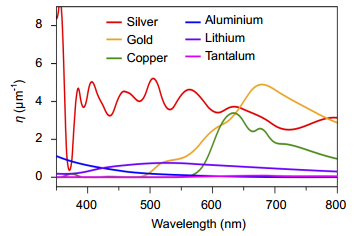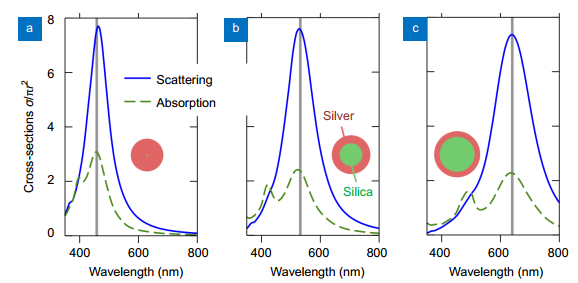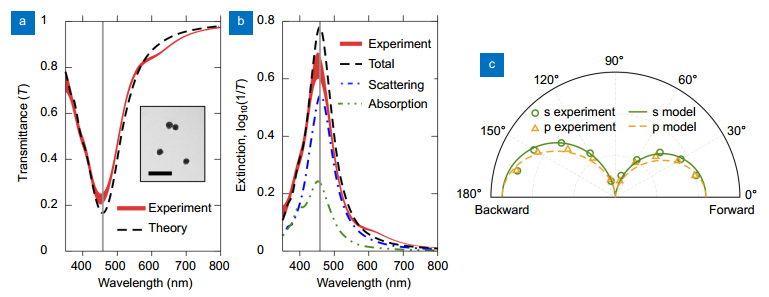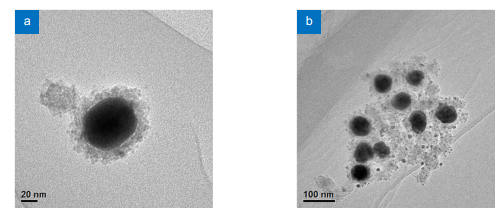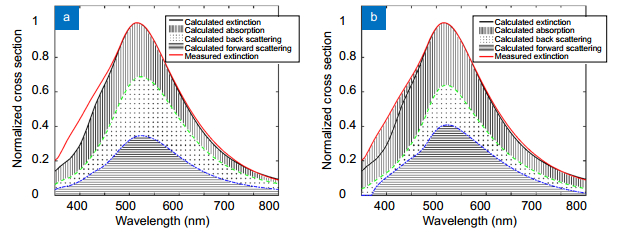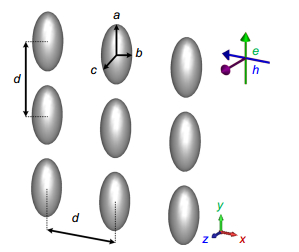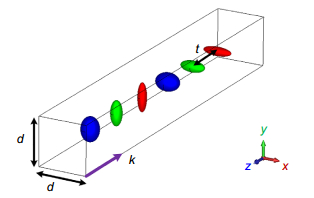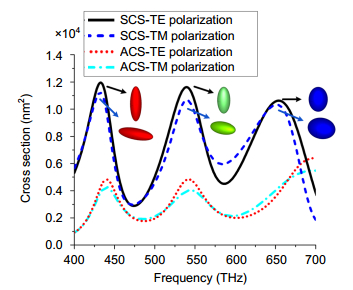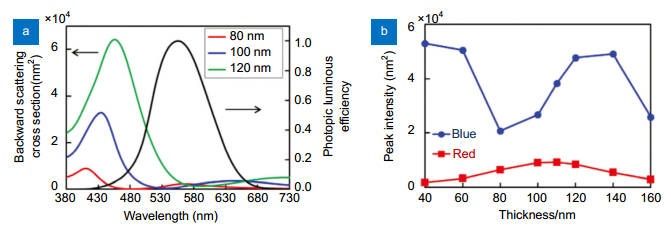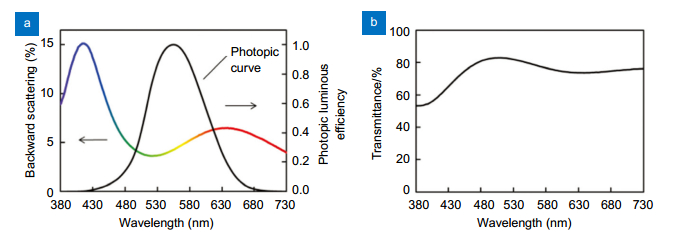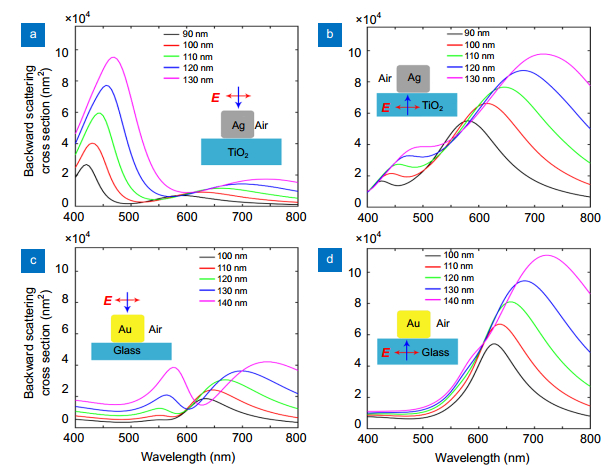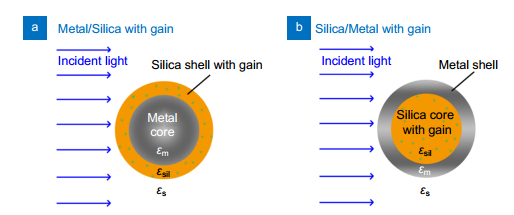| Citation: | Ye Y Y, Liu Z, Chen T P. Toward transparent projection display: recent progress in frequency-selective scattering of RGB light based on metallic nanoparticle’s localized surface plasmon resonance. Opto-Electron Adv 2, 190020 (2019). doi: 10.29026/oea.2019.190020 |
Toward transparent projection display: recent progress in frequency-selective scattering of RGB light based on metallic nanoparticle's localized surface plasmon resonance
-
Abstract
A transparent display simultaneously enables visualization of the images displayed on it as well as the view behind it, and therefore can be applied to, for instance, augmented reality (AR), virtual reality (VR), and head up display (HUD). Many solutions have been proposed for this purpose. Recently, the idea of frequency-selective scattering of red, green and blue light while transmitting visible light of other colours to achieve transparent projection display has been proposed, by taking advantage of metallic nanoparticle's localized surface plasmon resonance (LSPR). In this article, a review of the recent progress of frequency-selective scattering of red, green and blue light that are based on metallic nanoparticle's LSPR is presented. A discussion of method for choosing appropriate metal(s) is first given, followed by the definition of a figure of merit used to quantify the performance of a designed nanoparticle structure. Selective scattering of various nanostructures, including sphere-shaped nanoparticles, ellipsoidal nanoparticles, super-sphere core-shell nanoparticles, metallic nanocubes, and metallic nanoparticles combined with gain materials, are discussed in detail. Each nanostructure has its own advantages and disadvantages, but the combination of the metallic nanoparticle with gain materials is a more promising way since it has the potential to generate ultra-sharp scattering peaks (i.e., high frequency-selectivity). -

-
References
[1] Jang C, Lee C K, Jeong J, Li G, Lee S et al. Recent progress in see-through three-dimensional displays using holographic optical elements. Appl Opt 55, A71-A85 (2016). doi: 10.1364/AO.55.000A71 [2] Sun T, Pettitt G, Ho N T, Eckles K, Clifton B et al. Full color high contrast front projection on black emissive display. Proc SPIE 8254, (2012). doi: 10.1117/12.906619 [3] Chen S F, Deng L L, Xie J, Peng L, Xie L H et al. Recent developments in top-emitting organic light-emitting diodes. Adv Mater 22, 5227-5239 (2010). doi: 10.1002/adma.201001167 [4] Hsu C W, Zhen B, Qiu W J, Shapira O, DeLacy B G et al. Transparent displays enabled by resonant nanoparticle scattering. Nat Commun 5, 3152 (2014). doi: 10.1038/ncomms4152 [5] Saito K, Tatsuma T. A transparent projection screen based on plasmonic Ag nanocubes. Nanoscale 7, 20365-20368 (2015). doi: 10.1039/C5NR06766A [6] Monti A, Toscano A, Bilotti F. Analysis of the scattering and absorption properties of ellipsoidal nanoparticle arrays for the design of full-color transparent screens. J Appl Phys 121, 243106 (2017). doi: 10.1063/1.4990422 [7] Ye Y Y, Chen T P, Zhen J Y, Xu C, Zhang J et al. Resonant scattering of green light enabled by Ag@TiO2 and its application in a green light projection screen. Nanoscale 10, 2438-2446 (2018). doi: 10.1039/C7NR07383F [8] Kreibig U, Vollmer M. Optical Properties of Metal Clusters (Springer, Berlin, Heidelberg, 2013). [9] Kelly K L, Coronado E, Zhao L L, Schatz G C. The optical properties of metal nanoparticles: the influence of size, shape, and dielectric environment. J Phys Chem B 107, 668-677 (2003). doi: 10.1002/chin.200316243 [10] Ye Y Y, Liu R Y, Song Z G, Liu Z, Chen T P. Sharp selective scattering of red, green, and blue light achieved via gain material's loss compensation. Opt Express 27, 9189-9204 (2019). doi: 10.1364/OE.27.009189 [11] Kreibig U. Small silver particles in photosensitive glass: their nucleation and growth. Appl Phys 10, 255-264 (1976). doi: 10.1007/BF00897225 [12] Quinten M. Optical Properties of Nanoparticle Systems: Mie and Beyond (John Wiley & Sons, Weinheim, 2011). [13] Yang W. Improved recursive algorithm for light scattering by a multilayered sphere. Appl Opt 42, 1710-1720 (2003). doi: 10.1364/AO.42.001710 [14] Sullivan D M. Electromagnetic Simulation Using the FDTD Method 2nd ed (John Wiley & Sons, New Jersey, 2013). [15] Draine B T, Flatau PJ. Discrete-dipole approximation for scattering calculations. J Opt Soc Am A 11, 1491-1499 (1994). doi: 10.1364/JOSAA.11.001491 [16] Bohren C F, Clothiaux E E. Fundamentals of Atmospheric Radiation: An Introduction with 400 Problems (John Wiley & Sons, Weinheim, 2006). [17] Kucherenko S, Sytsko Y. Application of deterministic low-discrepancy sequences in global optimization. Comput Optim Appl 30, 297-318 (2005). doi: 10.1007/s10589-005-4615-1 [18] Johnson S G. The NLopt nonlinear-optimization package. Available from: https://nlopt.readthedocs.io/en/latest/, [cited 23rd March 2019, 2019] [19] Palik E D. Handbook of Optical Constants of Solids, 3. (Academic Press, San Diego, 1998). [20] Ye Y Y, Chen T P, Liu Z, Yuan X. Effect of surface scattering of electrons on ratios of optical absorption and scattering to extinction of gold nanoshell. Nano Res Lett 13, 299 (2018). doi: 10.1186/s11671-018-2670-7 [21] Kreibig U, Fragstein C V. The limitation of electron mean free path in small silver particles. Z Phys 224, 307-323 (1969). doi: 10.1007/BF01393059 [22] Tang S C, Tang Y F, Zhu S P, Lu H M, Meng X K. Synthesis and characterization of silica-silver core-shell composite particles with uniform thin silver layers. J Solid State Chem 180, 2871-2876 (2007). doi: 10.1016/j.jssc.2007.08.022 [23] DeVore J R. Refractive indices of rutile and sphalerite. J Opt Soc Am 41, 416-419 (1951). doi: 10.1364/JOSA.41.000416 [24] Seh Z W, Liu S H, Low M, Zhang S Y, Liu Z L et al. Janus Au-TiO2 photocatalysts with strong localization of plasmonic near-fields for efficient visible-light hydrogen generation. Adv Mater 24, 2310-2314 (2012). doi: 10.1002/adma.201104241 [25] Mergel D, Buschendorf D, Eggert S, Grammes R, Samset B. Density and refractive index of TiO2 films prepared by reactive evaporation. Thin Solid Films 371, 218-224 (2000). doi: 10.1016/S0040-6090(00)01015-4 [26] Blaber M G, Arnold M D, Ford M J. Search for the ideal plasmonic nanoshell: the effects of surface scattering and alternatives to gold and silver. J Phys Chem C 113, 3041-3045 (2009). doi: 10.1021/jp810808h [27] Berciaud S, Cognet L, Tamarat P, Lounis B. Observation of intrinsic size effects in the optical response of individual gold nanoparticles. Nano Lett 5, 515-518 (2005). doi: 10.1021/nl050062t [28] Scaffardi L B, Tocho J O. Size dependence of refractive index of gold nanoparticles. Nanotechnology 17, 1309-1315 (2006). doi: 10.1088/0957-4484/17/5/024 [29] Park J, Lu W. Orientation of core-shell nanoparticles in an electric field. Appl Phys Lett 91, 053113 (2007). doi: 10.1063/1.2767191 [30] Saeidi C, van der Weide D. Nanoparticle array based optical frequency selective surfaces: theory and design. Opt Express 21, 16170-16180 (2013). doi: 10.1364/OE.21.016170 [31] Monti A, Alù A, Toscano A, Bilotti F. Optical invisibility through metasurfaces made of plasmonic nanoparticles. J Appl Phys 117, 123103 (2015). doi: 10.1063/1.4916257 [32] Fruhnert M, Monti A, Fernandez-Corbaton I, Alù A, Toscano A et al. Tunable scattering cancellation cloak with plasmonic ellipsoids in the visible. Phys Rev B 93, 245127 (2016). doi: 10.1103/PhysRevB.93.245127 [33] Monti A, Toscano A, Bilotti F. Exploiting the surface dispersion of nanoparticles to design optical-resistive sheets and Salisbury absorbers. Opt Lett 41, 3383-3386 (2016). doi: 10.1364/OL.41.003383 [34] Ramaccia D, Toscano A, Bilotti F. Scattering and absorption from super-spherical nanoparticles: analysis and design for transparent displays [Invited]. J Opt Soc Am B 34, D62-D67 (2017). doi: 10.1364/JOSAB.34.000D62 [35] LAMÉ SURFACE. Available from: https://www.mathcurve.com/surfaces.gb/lame/lame.shtml, [cited 25 April 2019] [36] Miyazawa T, Aratake M, Onaka S. Superspherical-shape approximation to describe the morphology of small crystalline particles having near-polyhedral shapes with round edges. J Math Chem 50, 249-260 (2012). doi: 10.1007/s10910-011-9909-1 [37] Saito K, Tatsuma T. Asymmetric three-way plasmonic color routers. Adv Opt Mater 3, 883-887 (2015). doi: 10.1002/adom.201500111 [38] Ye Y Y, Chen T P. Selective scattering of blue and red light based on silver and gold nanocubes. ECS J Solid State Sci Technol 8, R51-R57 (2019). doi: 10.1149/2.0131903jss [39] Sherry L J, Chang S H, Schatz G C, Van Duyne R P, Wiley B J et al. Localized surface plasmon resonance spectroscopy of single silver nanocubes. Nano Lett 5, 2034-2038 (2005). doi: 10.1021/nl0515753 [40] Davis T J, Gómez D E, Vernon K C. Simple model for the hybridization of surface plasmon resonances in metallic nanoparticles. Nano Lett 10, 2618-2625 (2010). doi: 10.1021/nl101335z [41] Fang Z Y, Zhu X. Plasmonics in nanostructures. Adv Mater 25, 3840-3856 (2013). doi: 10.1002/adma.201301203 [42] Jellison G E Jr, Boatner L A, Budai J D, Jeong B S, Norton D P. Spectroscopic ellipsometry of thin film and bulk anatase (TiO2). J Appl Phys 93, 9537-9541 (2003). doi: 10.1063/1.1573737 [43] Avrutsky I. Surface plasmons at nanoscale relief gratings between a metal and a dielectric medium with optical gain. Phys Rev B 70, 155416 (2004). doi: 10.1103/PhysRevB.70.155416 [44] Noginov M A, Zhu G, Bahoura M, Adegoke J, Small C E et al. Enhancement of surface plasmons in an Ag aggregate by optical gain in a dielectric medium. Opt Lett 31, 3022-3024 (2006). doi: 10.1364/OL.31.003022 [45] Digonnet M J F. Rare-Earth-Doped Fiber Lasers and Amplifiers 2nd ed (CRC Press, New York, 2001). [46] Lawandy N M. Localized surface plasmon singularities in amplifying media. Appl Phys Lett 85, 5040 (2004). doi: 10.1063/1.1825058 [47] Hide F, Schwartz B J, Díaz-García M A, Heeger A J. Conjugated polymers as solid-state laser materials. Synth Met 91, 35-40 (1997). doi: 10.1016/S0379-6779(97)03971-4 [48] Gordon J A, Ziolkowski R W. The design and simulated performance of a coated nano-particle laser. Opt Express 15, 2622-2653 (2007). doi: 10.1364/OE.15.002622 [49] Li X F, Yu S F. Design of low-threshold compact Au-nanoparticle lasers. Opt Lett 35, 2535-2537 (2010). doi: 10.1364/OL.35.002535 [50] Campbell S D, Ziolkowski R W. Impact of strong localization of the incident power density on the nano-amplifier characteristics of active coated nano-particles. Opt Commun 285, 3341-3352 (2012). doi: 10.1016/j.optcom.2011.11.006 [51] Zhang H P, Zhou J, Zou W B, He M. Surface plasmon amplification characteristics of an active three-layer nanoshell-based spaser. J Appl Phys 112, 074309 (2012). doi: 10.1063/1.4757416 [52] Wu D J, Cheng Y, Wu X W, Liu X J. An active metallic nanomatryushka with two similar super-resonances. J Appl Phys 116, 013502 (2014). doi: 10.1063/1.4886696 [53] Li B W, Zu S, Zhou J D, Jiang Q, Du B W et al. Single-nanoparticle plasmonic electro-optic modulator based on MoS2 monolayers. ACS Nano 11, 9720-9727 (2017). doi: 10.1021/acsnano.7b05479 -
Supplementary Information
-
Access History

Article Metrics
-
Figure 1.
Schematic illustration of the concept of transparent projection display achieved by frequency-selective scattering of red, green and blue light.
-
Figure 2.
η as a function of wavelength in the visible light range for various metals.
-
Figure 3.
Calculated scattering and absorption cross-sections for Silica/Ag nanoparticles (embedding medium has a refractive index of 1.44).
-
Figure 4.
Characterization of the transparent projection film made by dispersing Ag nanospheres with average diameter of 62 nm in PVA.
-
Figure 5.
Comparison of the transparent projection display in work (left) with a normal piece of glass (right).
-
Figure 6.
(a) Optimized results for green light selective scattering. (b) Optimized results for red light selective scattering. (c) Angular distribution of scattered light for (a) at the wavelength of 525 nm. (d) Angular distribution of scattered light for (b) at the wavelength of 620 nm. Efficiency is the corresponding cross section (i.e., extinction, scattering or absorption) divided by the nanoparticle's geometrical cross section πr2, where r is core-shell structure's outer radius. The angular distributions of scattered light are calculated by assuming incident light has a unit intensity, and equal components for the p- and s- polarization with respect to the scattering plane. Calculations are done with Mie's theory. Figure reproduced by permission from Ref.7, The Royal Society of Chemistry.
-
Figure 7.
TEM images of the Ag/TiO2 core–shell structures.
-
Figure 8.
Comparison between (a) the theoretically calculated cross sections of absorption, and forward and backward scattering and (b) experimentally measured ones.
-
Figure 9.
(a) Image projected on the transparent projection display film that is fabricated by dispersing Ag/TiO2 into PVA. (b) A comparison film made of PVA without dispersion of Ag/TiO2. A laser projector (SONY MP-CL1A) is used for projection. In the projection experiment, green light with a wavelength of 523±3 nm is used. Figure reproduced by permission from Ref.7, The Royal Society of Chemistry.
-
Figure 10.
The proposed geometry array of Ag ellipsoids.
-
Figure 11.
(a) Initial optimization of Ag ellipsoids for selective scattering of the three basic additive colours (red, green and blue) based on FOM. For each basic array of Ag ellipsoids, the nanoparticles' major axis is varied from 20 nm to 40 nm while their eccentricity is fixed at 0.96, 0.9, and 0.81 for the red, green, and blue arrays, respectively. As a comparison, values of the FOM without consideration of effect of surface scattering of conduction electrons are also shown (dashed lines). (b) Calculated cross sections for scattering (SCS) and absorption (ACS) for a Ag ellipsoids array with the following parameters: a= 20 nm, b=c=12 nm, and d=100 nm. Both results with and without consideration of surface scattering of free electrons (i.e., the size-correction) are shown. Figure reprinted with permission from Ref.6, AIP Publishing.
-
Figure 12.
Proposed unit-cell of a full-color and almost polarization-independent transparent projection display screen achieved with Ag ellipsoid arrays.
-
Figure 13.
Scattering (SCS) and absorption (ACS) cross sections calculated for the display screen proposed in Fig. 12 under incident light with TE or TM polarization.
-
Figure 14.
3D angular scattering distribution for the optimized Ag ellipsoids in Table 3: (a) Ag ellipsoid array for red light scattering, (b) Ag ellipsoid array for green light scattering and (c) Ag ellipsoid array for blue light scattering
-
Figure 15.
(a) Schematic sketch of the shapes of super-sphere. The surface of the super-sphere is described by equation (7). Increasing polyhedricity parameter p will make a super-sphere approach to the shape of a cube. (b) Schematic of a super-sphere core-shell structure, with silica as core and Ag as shell. a1 and a2 are the inner and the outer radius of super-spheres, respectively. Dashed lines indicate the special case of the super-sphere core-shell structure when p=2, i.e., the perfect spherical case. Figure adapted with permission from Ref.34, Optical Society of America.
-
Figure 16.
(a) Optimized results of super-sphere for blue light selective scattering, a1=10 nm, a2=30 nm, p=2. (b) Optimized results of supersphere for green light selective scattering, a1=10 nm, a2=30 nm, p=7. (c) Optimized results of super-sphere for red light selective scattering, a1=44 nm, a2=30 nm, p=6. Insets show structures' corresponding geometric schematics and angular distribution of scattering. Figure adapted with permission from Ref.34, Optical Society of America.
-
Figure 17.
FDTD (finite-difference time-domain) simulations showing (a) a second peak emerges when a single Ag nanocube (edge length of 90 nm) approaches a glass substrate (index assumed to be 1.5), and the near field |E| plots for (b) peak 1 and (c) peak 2 of the nanocube placed on the glass substrate
-
Figure 18.
(a) Simulated backward scattering spectrums with FDTD for Ag nanocubes deposited on TiO2 with sufficient thickness (800 nm). The luminosity function is also shown to indicate that human eyes are not sensitive to blue and red light. In the calculations, TiO2's refractive index is from Ref.42, and Ag's refractive index is from Ref.19. (b) Calculated dependence of the distal and proximal mode backward scattering peak intensities of a 100 nm Ag nanocube on the TiO2 thickness. Figure reproduced with permission from Ref.5, The Royal Society of Chemistry.
-
Figure 19.
(a) Backward scattering spectrum and (b) transmittance spectrum of the transparent projection display sample experimentally prepared by depositing a monolayer of Ag nanocubes (with average edge length of 100 nm) on the film of TiO2 with thickness of 110 nm.
-
Figure 20.
(a) A colourful image is projected onto the display sample using an LCD projector (Epson EB-1761W, peak wavelengths of blue, green, and red light are at 442, 552, and 612 nm, respectively). (b) Transparency of the display sample when no image is projected. Figure reproduced with permission from Ref.5, The Royal Society of Chemistry.
-
Figure 21.
Backward scattering cross sections simulated with FDTD for Ag and Au nanocubes placed on dielectric substrate.
-
Figure 22.
Simulated results of the two proposed solutions to enhance backward scattering of red light.
-
Figure 23.
Proposed core-shell structures for combining metallic nanoparticle with gain material.
-
Figure 24.
Optimized results for selective scattering of red, green and blue light when gain materials are combined with metallic nanoparticles.

 E-mail Alert
E-mail Alert RSS
RSS

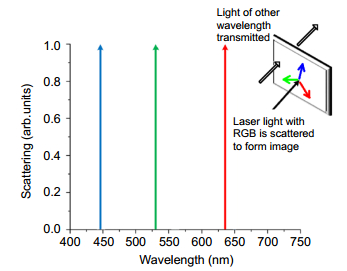

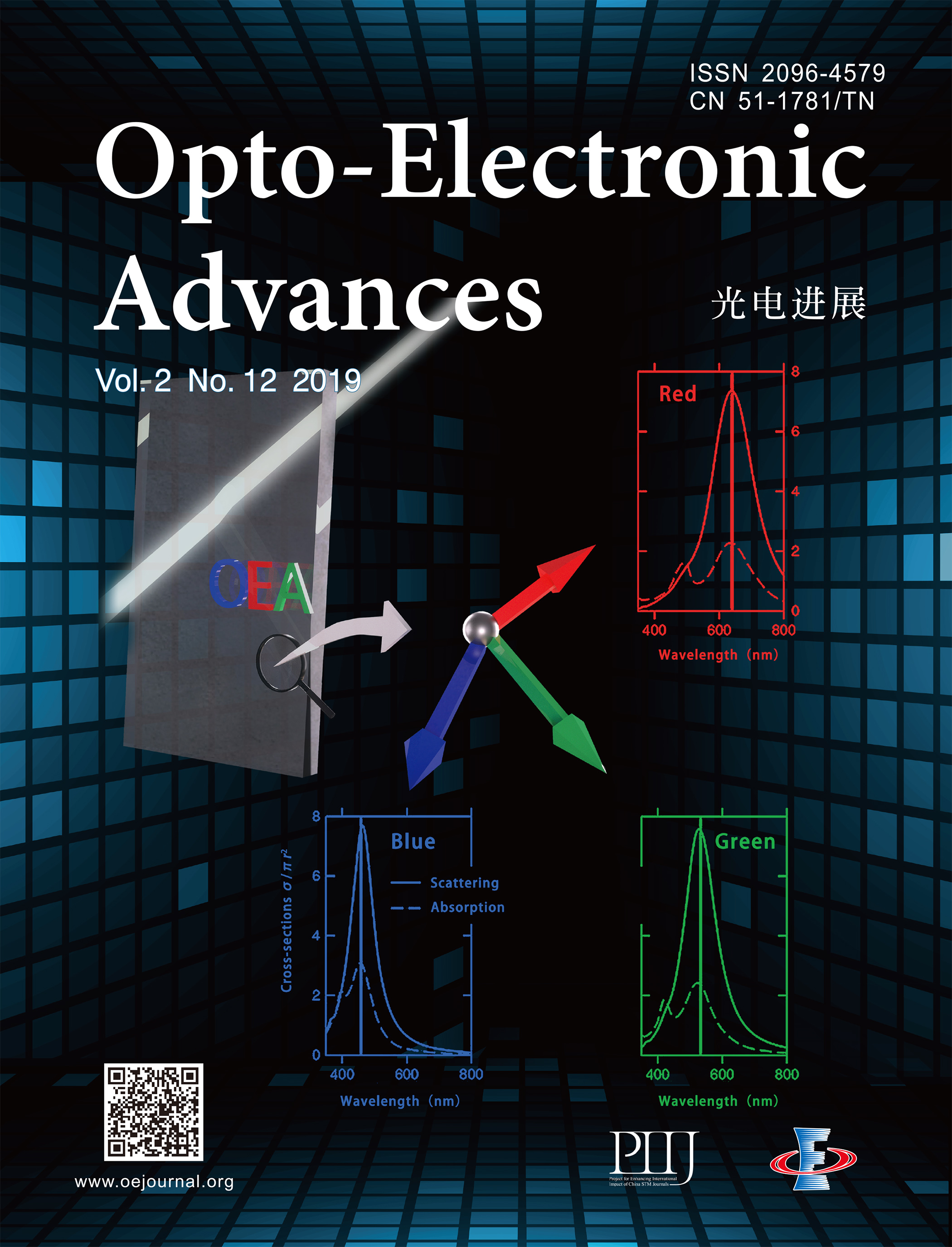
 DownLoad:
DownLoad:
